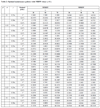- Home
- About Journals
-
Information for Authors/ReviewersEditorial Policies
Publication Fee
Publication Cycle - Process Flowchart
Online Manuscript Submission and Tracking System
Publishing Ethics and Rectitude
Authorship
Author Benefits
Reviewer Guidelines
Guest Editor Guidelines
Peer Review Workflow
Quick Track Option
Copyediting Services
Bentham Open Membership
Bentham Open Advisory Board
Archiving Policies
Fabricating and Stating False Information
Post Publication Discussions and Corrections
Editorial Management
Advertise With Us
Funding Agencies
Rate List
Kudos
General FAQs
Special Fee Waivers and Discounts
- Contact
- Help
- About Us
- Search

The Open Cybernetics & Systemics Journal
(Discontinued)
ISSN: 1874-110X ― Volume 12, 2018
Cost Optimization Model of Second-hand Product for Extended Non-renewing Replacement-repair Warranty
Ke Dong1, 2, Wen-yuan Lv1, *
Abstract
This paper proposes maintenance policy and length of maintenance period for second-hand products from the user’s perspective. When the second-hand product failure occurs during the basic warranty period, it is either replaced or minimally repaired. When the basic warranty period expires, the seller gives a discount to the user if he/she purchases the extended warranty for second-hand products. When the extended warranty period expires, the customer is in charge of the products’ maintenance for a fixed length of time and replaces the products at the end of such a maintenance period. In time of maintenance period, the second-hand product is minimally repaired at each failure. Such a maintenance model can be viewed as a generalization of several existing maintenance models which can be obtained as special cases. Following this maintenance scheme, the expected total cost of the mathematical model is constructed, and then the length of maintenance period is obtained so that the expected total cost is minimized for the user. Finally, numerical examples are introduced to illustrate the proposed optimal replacement strategy.
Article Information
Identifiers and Pagination:
Year: 2016Volume: 10
First Page: 101
Last Page: 111
Publisher Id: TOCSJ-10-101
DOI: 10.2174/1874110X01610010101
Article History:
Received Date: 28/07/2015Revision Received Date: 28/05/2016
Acceptance Date: 30/05/2016
Electronic publication date: 15/07/2016
Collection year: 2016
open-access license: This is an open access article licensed under the terms of the Creative Commons Attribution-Non-Commercial 4.0 International Public License (CC BY-NC 4.0) (https://creativecommons.org/licenses/by-nc/4.0/legalcode), which permits unrestricted, non-commercial use, distribution and reproduction in any medium, provided the work is properly cited.
* Address correspondence to this author at the Business School, University of Shanghai for Science and Technology, Shanghai, China; E-mail: wy_lv@sina.com
| Open Peer Review Details | |||
|---|---|---|---|
| Manuscript submitted on 28-07-2015 |
Original Manuscript | Cost Optimization Model of Second-hand Product for Extended Non-renewing Replacement-repair Warranty | |
1. INTRODUCTION
The used/second-hand product market has been becoming increasingly important in total market since early twenty-first century. Recycling and reusing used/second-hand product has significant potential for reducing the environmental impacts, and protects the environment by preventing the second-hand second from becoming waste. Moreover, recycling of second-hand product is one of the important ways to achieve a low-carbon economy. In addition, from the perspective of the seller, he/she can sell the product to other consumers to obtain maximum profits through reutilizing the used product. But the consumer is most concerned about the functionality and reliability of the product, so a product should be sold with a basic warranty period.
During the basic warranty period, the seller provides either a free replacement (pro rata replacement) or minimal repair when the product fails. Following the expiration of the basic warranty period, the user is solely in charge of the failure of the product. Therefore, an extended warranty of the product will be becoming increasingly popular between the seller and the user which has been extensively discussed in the literature [1S. Wu, and P. Longhurst, "Optimising age-replacement and extended non-renewing warranty policies in lifecycle costing", Int. J. Prod. Econ., vol. 130, no. 2, pp. 262-267, 2011.
[http://dx.doi.org/10.1016/j.ijpe.2011.01.007] , 2M. Shafiee, and S. Chukova, "Maintenance models in warranty: A literature review", Eur. J. Oper. Res., vol. 229, no. 3, pp. 561-572, 2013.
[http://dx.doi.org/10.1016/j.ejor.2013.01.017] ]. Several scholars have carried out researches of replacement warranty and repair warranty among various warranty policies. Sahin and Polatoglu [3S. Izzet, and H. Polatoglu, "Maintenance strategies following the expiration of warranty", IEEE Trans. Reliab., vol. 45, no. 2, pp. 220-228, 1996.
[http://dx.doi.org/10.1109/24.510805] ] investigated the replacement strategy when the renewing replacement warranty and non-renewing replacement warranty were expired. Subsequently, Jung and Park [4K.M. Jung, and D.H. Park, "Optimal maintenance policies during the post-warranty period", Reliab. Eng. Syst. Saf., vol. 82, no. 2, pp. 173-185, 2003.
[http://dx.doi.org/10.1016/S0951-8320(03)00144-3] ] extended their model by considering preventive maintenance activity. Jung et al. [5K.M. Jung, S.S. Han, and D.H. Park, "Optimization of cost and downtime for replacement model following the expiration of warranty", Reliab. Eng. Syst. Saf., vol. 93, no. 7, pp. 995-1003, 2008.
[http://dx.doi.org/10.1016/j.ress.2007.05.005] ] presented an optimal replacement policy after the replacement warranty was expired by considering both expected cost and expected downtime. Yeh et al. [6R.H. Yeh, M.Y. Chen, and C.Y. Lin, "Optimal periodic replacement policy for repairable products under free-repair warranty", Eur. J. Oper. Res., vol. 176, no. 3, pp. 1678-1686, 2007.
[http://dx.doi.org/10.1016/j.ejor.2005.10.047] ] determined an optimal replacement strategy for the repairable system under free-repair warranty. Jung et al. [7K.M. Jung, M. Park, and D.H. Park, "System maintenance cost dependent on life cycle under renewing warranty policy", Reliab. Eng. Syst. Saf., vol. 95, no. 7, pp. 816-821, 2010.
[http://dx.doi.org/10.1016/j.ress.2010.02.010] ] defined a new concept of the life cycle anew from the user’s point of view and considered the optimal maintenance policy following the expiration of the renewing warranty. Recently, Jung et al. [8K.M. Jung, M. Park, and D.H. Park, "Optimal maintenance strategy for non-renewing replacement-repair warranty", Appl. Stochastic Models Data Anal., vol. 28, no. 6, pp. 607-614, 2012.
[http://dx.doi.org/10.1002/asmb.950] ] presented an optimal maintenance strategy for repairable system after the non-renewing replacement-repair warranty was expired. What’s more, Jung et al. [9K.M. Jung, M. Park, and D.H. Park, "Cost optimization model following extended renewing two-phase warranty", Comput. Ind. Eng., vol. 79, pp. 188-194, 2015.
[http://dx.doi.org/10.1016/j.cie.2014.10.016] ] investigated an extend model by taking into account additional warranty period to the users after the original two-phase warranty was expired.
In contrast with various researches on new products, a literature review shows that only a few types of researches have been done on maintenance strategy for second-hand product to minimize the expected cost from the manufacturer’s or the user’s perspective [2M. Shafiee, and S. Chukova, "Maintenance models in warranty: A literature review", Eur. J. Oper. Res., vol. 229, no. 3, pp. 561-572, 2013.
[http://dx.doi.org/10.1016/j.ejor.2013.01.017] ]. In recent years, the concept of “warranty for second-hand products” has aroused the interest of several researchers, for example, Chattopadhyay and Murthy [10G.N. Chattopadhyay, and D.N. Murthy, "Warranty cost analysis for second-hand products", Math. Comput. Model., vol. 31, pp. 81-88, 2000.
[http://dx.doi.org/10.1016/S0895-7177(00)00074-1] ], Chukova et al. [11S. Chukova, and M. Shafiee, "One-dimensional warranty cost analysis for second-hand items: An overview", Int. J. Qual. Reliab. Manage., vol. 30, no. 3, pp. 239-255, 2013.
[http://dx.doi.org/10.1108/02656711311299827] ], and Shafiee et al. [12S.G. Naini, and M. Shafiee, "Joint determination of price and upgrade level for a warranted second-hand product", Int. J. Adv. Manuf. Technol., vol. 54, no. 9, pp. 1187-1198, 2011.
[http://dx.doi.org/10.1007/s00170-010-2994-7] ]. With a large number of second-hand products flooding into the market including automobiles, helicopters, TVs, furniture, etc, providing warranty services for second-hand products has been a relatively new marketing strategy employed by manufacturers or sellers. The second-hand warranty contract which is made by the seller and the user can assure the new users that the second-hand product will function well for a preset period of time or amount of usage.
In this paper, we will propose a decision model to determine the optimal length of maintenance period for second-hand products from the user’s perspective. We will introduce two types of warranties which are the non-renewing free replacement-repair warranty (NFRRW) and the non-renewing pro rata replacement-repair warranty (NPRRW), and we also will compare the optimal results of these two warranty strategies via numerical examples.
The remainder of this article will be organized as follows. In section 2, we will derive the expected cost rate from the user’s point of view by formulating the expected warranty cost and the length of the life cycle of the system. In section 3, we will discuss the optimal maintenance strategy and prove the uniqueness of the solution for the decision variable. Numerical results will be provided in section 4. Finally, concluding remarks will begiven in section 5.
2. MAINTENANCE MODEL FOLLOWING EXTENDED NON-RENEWING REPLACEMENT-REPAIR WARRANTY
We will investigate the maintenance model following the extended non-renewing replacement-repair warranty (NRRW) and its optimization of second-hand product in this section. The extended maintenance model is the combination of basic warranty, extended warranty and maintenance period. The basic warranty interval will be divided into two non-overlapping subintervals, non-renewing replace warranty(NRW) period and non-renewing minimal repair warranty(NMW) period. If the second-hand product fails during the NRW period of the basic warranty, the seller will replace it by another one either under NFRRW or under the NPRRW. Under the NFRRW, the seller will be fully responsible for the replacement cost. However, under the NPRRW, a pro-rated portion of replacement cost will be charged to the user proportionally to the usage age of the system when it fails. If the system fails during the NMW phase of the basic warranty period, the user is not responsible for any of the minimal repair cost under NFRRW, but should be responsible for the minimal repair cost under NPRRW. During the extended warranty period, the seller will be in charge of the minimal repair cost under both NFRRW and NPRRW. The minimal repair action restores the system to functioning state but will not change its hazard rate. Following the expiration of the basic warranty period, the user purchases an extended warranty from the seller which is of a fixed length α. When the user purchases extended warranty as n(n≥1) times, the seller will give a special discount ϕ of purchasing extended warranty expense ce. Hence, the user will not be in charge of the minimal repair expense during the extended warranty period under both NFRRW and NPRRW. Following the expiration of the extended warranty period, only the minimal repair action will be conducted and the user will just be responsible for the expense over the maintenance period, and the system will be replaced with another one with a fixed length τ at the end of such a maintenance period, regardless of the age of the system. Fig. (1 ) illustrates the maintenance model after the extended NRRW in this article.
) illustrates the maintenance model after the extended NRRW in this article.
 |
Fig. (1) Maintenance model with the NRRW following extended warranty. |
3. FORMULATION OF EXPECTED COST RATE
Suppose that during the NRW phase of the basic warranty period, the system is replaced for k times, and y is the age of the system in use. We also assumed that k and y are known, and the kth replacement of the second-hand product’s age is A. Similar to the definition in Jung et al. [7K.M. Jung, M. Park, and D.H. Park, "System maintenance cost dependent on life cycle under renewing warranty policy", Reliab. Eng. Syst. Saf., vol. 95, no. 7, pp. 816-821, 2010.
[http://dx.doi.org/10.1016/j.ress.2010.02.010] ], we define that the life cycle of a system begins with the installation of a second-hand product and ends when the system is replaced by another second-hand one at the end of maintenance period. Thus, under the non-renewing replacement-repair warranty strategy, the life cycle starts with the installation of a second-hand product and ends with the replacement of another second-hand one after the expiration of the maintenance period regardless of the number of replacements during the NRW phase. Therefore, the expected life cycle length of the proposed model is
 .
.
We use the cost-related random variables
 denoting cost of the basic warranty period, the cost of extended warranty period, the cost of maintenance period and the cost of the replacement at the end of the life cycle, respectively. Then, we will obtain the expected total cost ETC(τ) as follows.
denoting cost of the basic warranty period, the cost of extended warranty period, the cost of maintenance period and the cost of the replacement at the end of the life cycle, respectively. Then, we will obtain the expected total cost ETC(τ) as follows.
 |
(1) |
Each of the expected cost, which is given in Eq. (1), can be evaluated as below:
 |
(2) |
 |
(3) |
 |
(4) |
and E(Cr)=Cr. Hence, the expected total cost can be represented as:
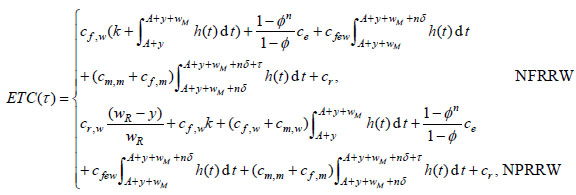 |
(5) |
Subsequently, the expected cost rate per unit time during the life cycle of the system can be derived as:
 |
(6) |
where,
 |
(7) |
If the product of replacement is new, thus, the age A of the product is 0, and the extended warranty period δ = 0, then Eq. (7) is degenerated to the following form, which is equivalent to the result of Jung et al. [13P.M. Jung Ki Mun, "Park Dong Ho, Optimal maintenance strategy for non-renewing replacement-repair warranty", Appl. Stochastic Models Data Anal., vol. 28, no. 9, pp. 607-614, 2012.
[http://dx.doi.org/10.1002/asmb.950] ]:
 |
(8) |
where,
 |
(9) |
If the age A of the product is 0, and do not consider the non-renewing repair warranty phase of the basic warranty period, which means that the value of wMis 0, then Eq. (7) is reduced to the following form, which is same with Sahin and Polatoglu’s [3S. Izzet, and H. Polatoglu, "Maintenance strategies following the expiration of warranty", IEEE Trans. Reliab., vol. 45, no. 2, pp. 220-228, 1996.
[http://dx.doi.org/10.1109/24.510805] ]:
 |
(10) |
Also, that If the product of replacement is new, and do not consider the non-renewing replacement warranty phase of the basic warranty period, which means that the value of wR is 0, then Eq. (7) is degenerated to the following expected cost rate per unit time, which is same as the result of Yeh et al. [6R.H. Yeh, M.Y. Chen, and C.Y. Lin, "Optimal periodic replacement policy for repairable products under free-repair warranty", Eur. J. Oper. Res., vol. 176, no. 3, pp. 1678-1686, 2007.
[http://dx.doi.org/10.1016/j.ejor.2005.10.047] ]:
 |
(11) |
4. OPTIMIZATION
In this section, we will derive the optimal length of maintenance period after the extended warranty by determining the value of τ, which minimizes C(τ). Hence, we consider the optimization problem as acquiring the value of τ*, which satisfies C(τ*)=min0≤τ≤∞C(τ). In order to get the value of τ* defined forward, we make the derivative of C(τ) with respect to τ has a value of zero. Thus, we get the following expression:
 |
(12) |
We prove the uniqueness of the solution for Eq. (12) by using the concept of pseudo-convexity of a function. If the cost function given in Eq. (6) is pseudo-convexity, then it has only one local minimum, and thus there exists a unique global minimum [3S. Izzet, and H. Polatoglu, "Maintenance strategies following the expiration of warranty", IEEE Trans. Reliab., vol. 45, no. 2, pp. 220-228, 1996.
[http://dx.doi.org/10.1109/24.510805] ].
4.1. Lemma
If F is an IFR distribution with strictly increasing failure rate function, then C(τ), given in Eq. (6), is pseudo-convex in τ≥0 for a given n.
Proof. Let G(τ) represent the expression in the numerator of Eq. (6). Then we obtain the following relations.
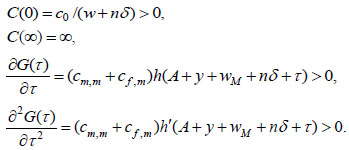 |
Hence, G(τ) is positive and convex. Since ETC(τ) is linear in τ and positive, C(τ) is pseudo-convex in G(τ).
4.2. Theorem
If F is an IFR distribution with strictly increasing failure rate function and n ≥ 1 is given, then τ* if and only if

 and
and
 is the unique solution of Eq. (6) if and only if
is the unique solution of Eq. (6) if and only if
 |
Proof. With the use of the property of pseudo-convexity of C(τ) and Eq. (12), it is straightforward to prove Theorem 4.2. Thus, we obtain the optimal length of maintenance period of proposed model that follows the extended warranty from Theorem 4.2.
5. NUMERICAL EXAMPLES
This section will present numerical examples to illustrate the proposed methods discussed above under both NFRRW and NPRRW. The failure times of a system are assumed to follow a Weibull distribution with the failure rate of h(t)=βλβtβ-1 for t≥0, where λ>0 and β>1 (h(t) is an increasing function), and the value of parameters can be obtained by Monte Carlo methods [14V.Z. Averbukh, "Pricing American Options Using Monte Carlo Simulation", Cornell University, 1997., 15P. Glasserman, Monte Carlo methods in financial engineering., vol. 53. Springer Science & Business Media, 2003.
[http://dx.doi.org/10.1007/978-0-387-21617-1] ]. The parameters cm,m and can cr be obtained by Black-Scholes equations [16S. Wang, S. Zhang, and Z. Fang, "A superconvergent fitted finite volume method for Black-Scholes equations governing European and American option valuation", Numer. Methods Partial Differ. Equ., vol. 31, no. 4, pp. 1190-1208, 2015.
[http://dx.doi.org/10.1002/num.21941] ]. Suppose that the parameter values are given in Table 1 and cr,w=cr for computational use. Using these parameter values, we derive the optimal length of the maintenance period, denoted by τ*, and the corresponding expected cost rate C(τ*).
In Fig. 1 , when wr =0.1, y=0.25 wr , A=0.1, and the expense of replacement cr=30, we consider various choices of β under NFRRW. For example, when β=2, the optimal maintenance period τ*=1.5662, and C(τ*)=18.5473. From Fig. (1
, when wr =0.1, y=0.25 wr , A=0.1, and the expense of replacement cr=30, we consider various choices of β under NFRRW. For example, when β=2, the optimal maintenance period τ*=1.5662, and C(τ*)=18.5473. From Fig. (1 ), we can also obtain the conclusion that when β increases, τ* decreases, and C(τ*) increases. The triangular sign symbols the optimal maintenance period τ* and C(τ*) in Fig. (1
), we can also obtain the conclusion that when β increases, τ* decreases, and C(τ*) increases. The triangular sign symbols the optimal maintenance period τ* and C(τ*) in Fig. (1 ). In Fig. (2
). In Fig. (2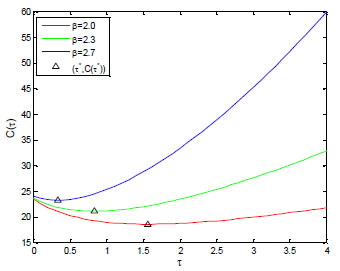 ), the parameter value β=2, and the other parameter is the same with Fig. (1
), the parameter value β=2, and the other parameter is the same with Fig. (1 ). we consider various choices of parameter A under NFRRW. For example, when A=0.25, the optimal maintenance period τ*=1.5086, and C(τ*)=19.1016. When A increases, τ* decreases, and C(τ*) increases. Figs.(3
). we consider various choices of parameter A under NFRRW. For example, when A=0.25, the optimal maintenance period τ*=1.5086, and C(τ*)=19.1016. When A increases, τ* decreases, and C(τ*) increases. Figs.(3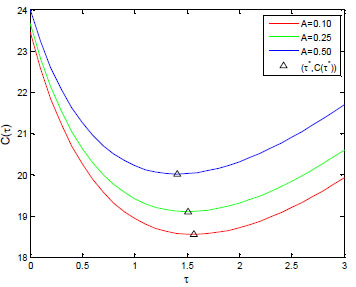 and 4
and 4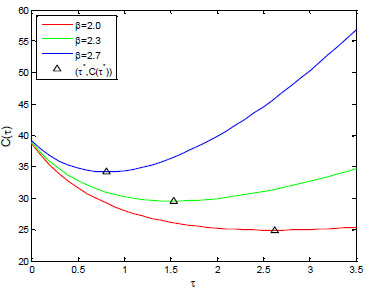 ) consider the situation under NPRRW, and they have the similar results with 1
) consider the situation under NPRRW, and they have the similar results with 1 and 2
and 2 .
.
 |
Fig. (2) Optimal maintenance period under NFRRW when β takes different values. |
 |
Fig. (3) Optimal maintenance period under NPRRW when initial age A takes different values. |
 |
Fig. (4) Optimal maintenance period under NFRRW when β takes different values. |
In Table 2, the optimal maintenance period denoted by τ*, is obtained by minimizing the expected cost rate function C(τ) of Eq. (6). We list the value of τ* and corresponding expected cost rate C(τ*) when the parameters β and A take different values. Table 3 provides similar patterns with Table 2 except that the parameter wr takes a different value.
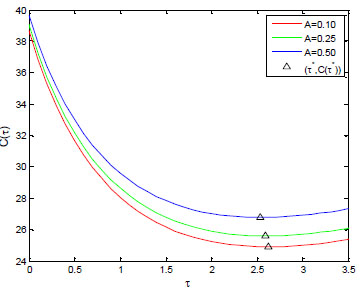 |
Fig. (5) Optimal maintenance period under NPRRW when initial age A takes different values. |
From Figs. (2 -5
-5 ), Tables 2 and 3, we summarize the effect of the relevant parameters on τ* and C(τ*) as follows:
), Tables 2 and 3, we summarize the effect of the relevant parameters on τ* and C(τ*) as follows:
- When the value of β increases, τ* decreases, and C(τ*) increases under both NFRRW and NPRRW. Thus, we can conclude reasonably that when the system functions with a high failure rate, it is more beneficial for the user to utilize the system for short maintenance period.
- When the initial age A of the second-hand product increases, τ* decreases, and C(τ*) increases under both NFRRW and NPRRW. Therefore, we can also draw the conclusion that it is more beneficial for the user to use the system for short maintenance period when the initial age increases.
- When the value of cr increases, τ* becomes longer, and C(τ*) increases. Thus, it is more beneficial for the user to utilize the system for long maintenance period when the expense of replacement increases.
- The expected cost rate is always higher under the NPRRW than under the NFRRW.
CONCLUSION
This paper has investigated the optimal maintenance period following an extended replacement-repair warranty of the second-hand product. Due to the saturated market and the development of science and technology, increasingly complex and high priced products flow into the market. Also an extended warranty of the second-hand product when the basic replacement-repair warranty is expired attracts more attention of the user. Furthermore, the effective maintenance of the system following the extended warranty by the user makes sure the system works well and minimizes the operating cost. Therefore, we present a model of extended replacement-repair warranty .When the initial age is zero and there is no extended warranty period, our model will degenerate to Jung et al. [8K.M. Jung, M. Park, and D.H. Park, "Optimal maintenance strategy for non-renewing replacement-repair warranty", Appl. Stochastic Models Data Anal., vol. 28, no. 6, pp. 607-614, 2012.
[http://dx.doi.org/10.1002/asmb.950] ]. When A=0, α=0, and wm=0, our model is degenerated to the result of Sahin and Polatoglu [3S. Izzet, and H. Polatoglu, "Maintenance strategies following the expiration of warranty", IEEE Trans. Reliab., vol. 45, no. 2, pp. 220-228, 1996.
[http://dx.doi.org/10.1109/24.510805] ]. Also note that if A=0, α=0, and wR=0, it is same as the result of Yeh et al. [6R.H. Yeh, M.Y. Chen, and C.Y. Lin, "Optimal periodic replacement policy for repairable products under free-repair warranty", Eur. J. Oper. Res., vol. 176, no. 3, pp. 1678-1686, 2007.
[http://dx.doi.org/10.1016/j.ejor.2005.10.047] ]. In addition, we make a contrast between NFRRW and NPRRW. Subsequently, we analyze the effect of several parameters on the length of maintenance period and expected cost rate per unit time. The generalization of this extended model of the two-dimensional cases would be very interesting, so this will be our future research orientation.
LIST OF ABBREVIATIONS
| ϕ | = The discount rate of purchasing extended warranty expense |
| τ | = Length of maintenance period after the NRRW is expired |
| ä | = Length of each extended warranty |
| A | = The age of the second-hand product |
| C(τ) | = Expected cost rate per unit time |
| Ce | = Unit cost of purchasing extended warranty |
| Cfew | = Unit failure cost during the extended warranty period |
| Cfm | = Unit failure cost during the maintenance period |
| Cf,w | = Unit failure cost of minimal repair during the warranty period |
| Cmm | = Unit cost of minimal repair during the maintenance period |
| Cm,w | = Unit cost of minimal repair during the warranty period |
| Cr | = Unit replacement cost at the end of the maintenance period |
| Crw | = Unit replacement cost during the warranty period |
| ECL(τ) | = Expected length of life cycle |
| ETC(τ) | = Expected total cost |
| F(t), f(t) | = Life distribution and probability density function of T |
| H(t) | = Failure rate function |
| K | = Number of replacements during the NRRW period |
| N | = Number of extended warranty periods |
| NFMW | = Non-renewing free minimal repair warranty |
| NFRRW | = Non-renewing free replacement-repair warranty |
| NFRW | = Non-renewing free replacement warranty |
| NMW | = Non-renewing minimal repair warranty |
| NPMW | = Non-renewing pro rata repair warranty |
| NPRRW | = Non-renewing pro rata replacement-repair warranty |
| NPRW | = Non-renewing pro rata replacement warranty |
| NRRW | = Non-renewing replacement-repair warranty |
| NRW | = Non-renewing replacement warranty |
| T | = Time to failure of a system |
| W | = Basic two-phase warranty period |
| WM | = NMW period |
| Wr | = NRW period |
| Y+A | = Age of the system in use at the end of the NRRW period |
CONFLICT OF INTEREST
The authors confirm that this article content has no conflict of interest.
ACKNOWLEDGEMENTS
This research is supported by a grant (No. 71471116) from the National Natural Science Foundation, China, the Key Program of Anhui Humanities and Social Science, China (No. SK2015A649), and the Shanghai First-Class Academic Discipline Project, China (No. S1201YLXK).
REFERENCES
| [1] | S. Wu, and P. Longhurst, "Optimising age-replacement and extended non-renewing warranty policies in lifecycle costing", Int. J. Prod. Econ., vol. 130, no. 2, pp. 262-267, 2011. [http://dx.doi.org/10.1016/j.ijpe.2011.01.007] |
| [2] | M. Shafiee, and S. Chukova, "Maintenance models in warranty: A literature review", Eur. J. Oper. Res., vol. 229, no. 3, pp. 561-572, 2013. [http://dx.doi.org/10.1016/j.ejor.2013.01.017] |
| [3] | S. Izzet, and H. Polatoglu, "Maintenance strategies following the expiration of warranty", IEEE Trans. Reliab., vol. 45, no. 2, pp. 220-228, 1996. [http://dx.doi.org/10.1109/24.510805] |
| [4] | K.M. Jung, and D.H. Park, "Optimal maintenance policies during the post-warranty period", Reliab. Eng. Syst. Saf., vol. 82, no. 2, pp. 173-185, 2003. [http://dx.doi.org/10.1016/S0951-8320(03)00144-3] |
| [5] | K.M. Jung, S.S. Han, and D.H. Park, "Optimization of cost and downtime for replacement model following the expiration of warranty", Reliab. Eng. Syst. Saf., vol. 93, no. 7, pp. 995-1003, 2008. [http://dx.doi.org/10.1016/j.ress.2007.05.005] |
| [6] | R.H. Yeh, M.Y. Chen, and C.Y. Lin, "Optimal periodic replacement policy for repairable products under free-repair warranty", Eur. J. Oper. Res., vol. 176, no. 3, pp. 1678-1686, 2007. [http://dx.doi.org/10.1016/j.ejor.2005.10.047] |
| [7] | K.M. Jung, M. Park, and D.H. Park, "System maintenance cost dependent on life cycle under renewing warranty policy", Reliab. Eng. Syst. Saf., vol. 95, no. 7, pp. 816-821, 2010. [http://dx.doi.org/10.1016/j.ress.2010.02.010] |
| [8] | K.M. Jung, M. Park, and D.H. Park, "Optimal maintenance strategy for non-renewing replacement-repair warranty", Appl. Stochastic Models Data Anal., vol. 28, no. 6, pp. 607-614, 2012. [http://dx.doi.org/10.1002/asmb.950] |
| [9] | K.M. Jung, M. Park, and D.H. Park, "Cost optimization model following extended renewing two-phase warranty", Comput. Ind. Eng., vol. 79, pp. 188-194, 2015. [http://dx.doi.org/10.1016/j.cie.2014.10.016] |
| [10] | G.N. Chattopadhyay, and D.N. Murthy, "Warranty cost analysis for second-hand products", Math. Comput. Model., vol. 31, pp. 81-88, 2000. [http://dx.doi.org/10.1016/S0895-7177(00)00074-1] |
| [11] | S. Chukova, and M. Shafiee, "One-dimensional warranty cost analysis for second-hand items: An overview", Int. J. Qual. Reliab. Manage., vol. 30, no. 3, pp. 239-255, 2013. [http://dx.doi.org/10.1108/02656711311299827] |
| [12] | S.G. Naini, and M. Shafiee, "Joint determination of price and upgrade level for a warranted second-hand product", Int. J. Adv. Manuf. Technol., vol. 54, no. 9, pp. 1187-1198, 2011. [http://dx.doi.org/10.1007/s00170-010-2994-7] |
| [13] | P.M. Jung Ki Mun, "Park Dong Ho, Optimal maintenance strategy for non-renewing replacement-repair warranty", Appl. Stochastic Models Data Anal., vol. 28, no. 9, pp. 607-614, 2012. [http://dx.doi.org/10.1002/asmb.950] |
| [14] | V.Z. Averbukh, "Pricing American Options Using Monte Carlo Simulation", Cornell University, 1997. |
| [15] | P. Glasserman, Monte Carlo methods in financial engineering., vol. 53. Springer Science & Business Media, 2003. [http://dx.doi.org/10.1007/978-0-387-21617-1] |
| [16] | S. Wang, S. Zhang, and Z. Fang, "A superconvergent fitted finite volume method for Black-Scholes equations governing European and American option valuation", Numer. Methods Partial Differ. Equ., vol. 31, no. 4, pp. 1190-1208, 2015. [http://dx.doi.org/10.1002/num.21941] |





